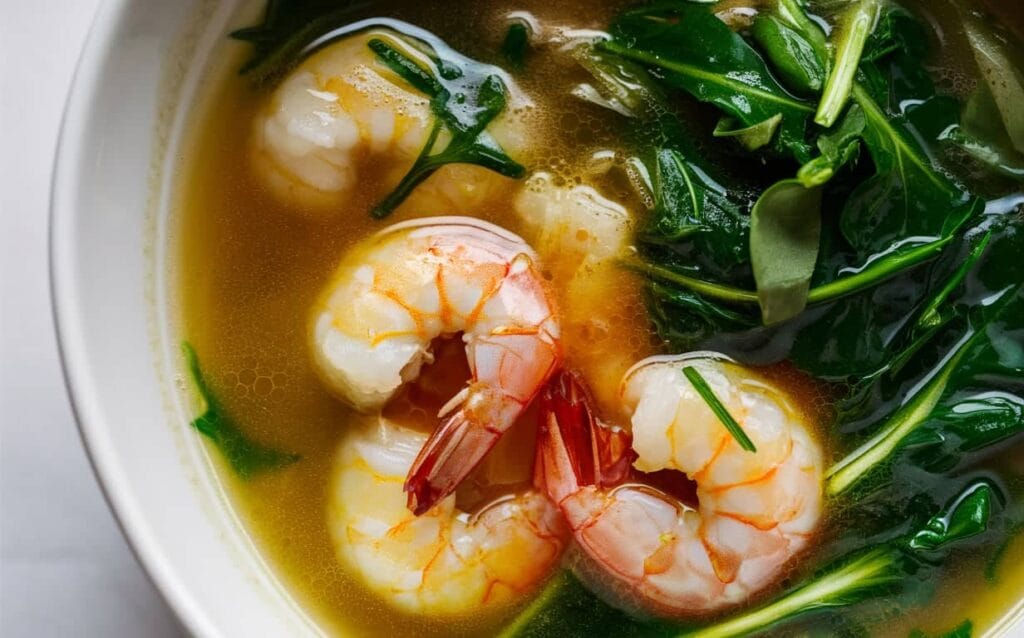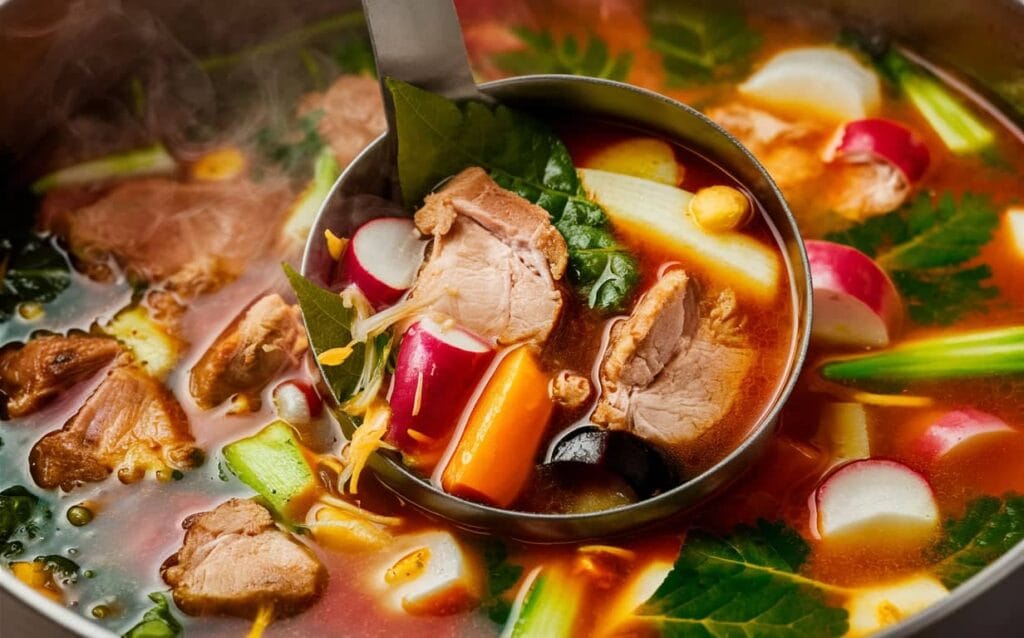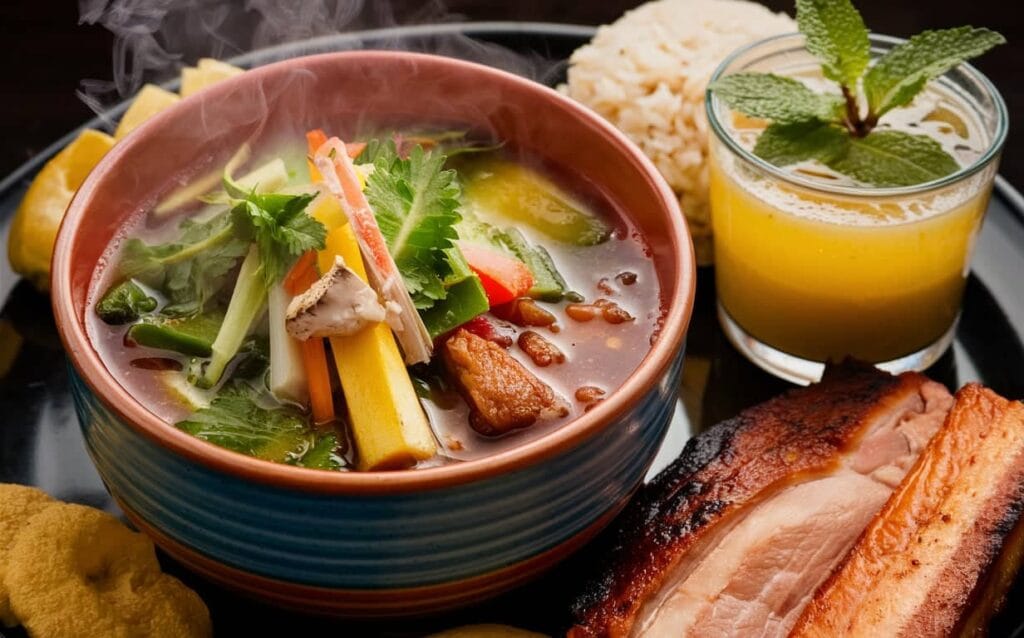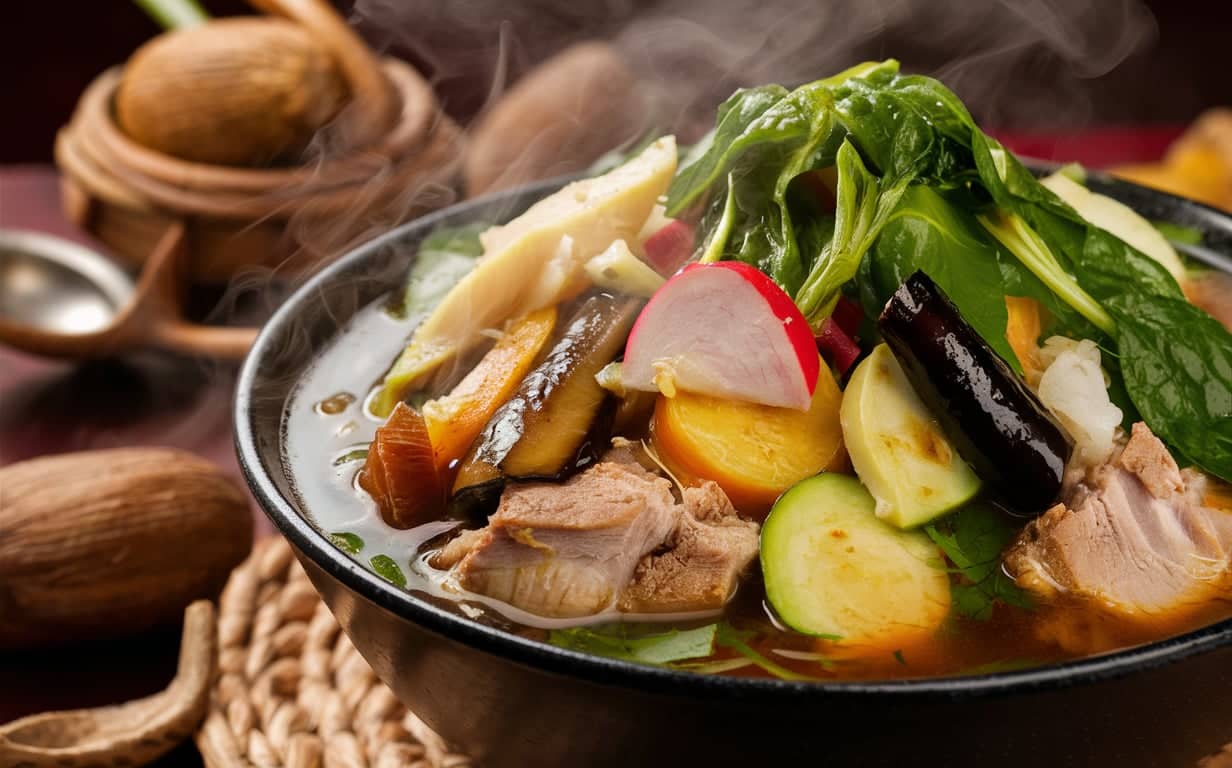Sinigang Recipe is more than just a soup; it’s a culinary treasure deeply rooted in Filipino culture. Known for its distinct tangy and savory flavor, sinigang Recipe is a beloved dish that brings warmth and comfort to the dining table. Whether it’s served during rainy days or festive family gatherings, its unique taste and aroma make it a go-to comfort food for many Filipinos.
The dish is versatile, adaptable, and highly customizable, catering to various tastes and preferences. Whether made with pork, shrimp, beef, or milkfish, sinigang always has one defining characteristic: its sourness. This flavor, often achieved using tamarind, distinguishes Sinigang Recipe from other soups around the world. Its tangy profile not only excites the palate but also evokes memories of home for those who grew up eating it.
In this article, we’ll explore everything about Sinigang from its history and variations to step-by-step instructions for cooking the perfect bowl. You’ll also learn tips to enhance its flavor, the health benefits it offers, and how to pair it with other dishes to elevate your dining experience. Ready to dive into the world of Sinigang? Let’s get started!
Table of contents
What is Sinigang Recipe?
Definition and Origin
Sinigang Recipe is a traditional Filipino soup or stew, widely known for its sour and savory taste. The word “sinigang,” derived from the Tagalog verb sigang, meaning “to stew,” immediately evokes a sense of nostalgia and comfort. Notably, this dish is synonymous with Filipino comfort food, cherished for its unique tangy flavor, which perfectly balances with a rich, hearty broth.
Interestingly, historians suggest that Sinigang has been part of Filipino culinary traditions for centuries. With its origins tied to the natural abundance of souring fruits and vegetables in the tropical Philippines, the dish reflects the region’s agricultural diversity. For instance, ingredients like tamarind, calamansi, and guava have historically been used to create the dish’s distinctive sour base. Consequently, Sinigang has become a delicious embodiment of the Philippines’ rich culinary heritage.
Key Characteristics
The most distinguishing feature of Sinigang is its sourness, achieved through souring agents like tamarind (sampalok), green mango, or even tomatoes. This tangy profile is complemented by a variety of vegetables, including radish (labanos), eggplant, water spinach (kangkong), and okra, along with a protein of choice, such as pork, shrimp, or fish. The result is a hearty, flavorful soup that brings together the essence of Filipino cuisine: simple, flavorful, and deeply satisfying.
Sinigang Recipe is celebrated not only for its delicious taste but also for its versatility. Each household may have its own twist on the dish, adding unique ingredients or adjusting the sourness to suit personal preferences. It’s not just food—it’s a shared experience that brings families together around the table.
Health Benefits of Sinigang
Nutritional Value
Sinigang Recipe is not only a treat for the taste buds but also a powerhouse of nutrition. Packed with a variety of vegetables, lean proteins, and nutrient-rich souring agents, it offers a balanced meal in a single bowl. Here’s a breakdown of its nutritional benefits:
- Rich in Vitamins and Minerals:
Vegetables like radish, water spinach, eggplant, and okra provide a wealth of vitamins such as A, C, and K, as well as minerals like potassium and calcium. These nutrients support overall health, boosting the immune system and improving bone strength. - Protein Source:
Depending on the protein used pork, shrimp, beef, or fish Sinigang provides essential amino acids necessary for muscle repair and growth. For seafood variants, omega-3 fatty acids contribute to heart health. - Low-Calorie and Filling:
Sinigang is generally low in calories, especially when made with lean meats or fish and minimal oil. The fiber from the vegetables adds bulk, promoting satiety and aiding digestion.
Immune-Boosting Properties
The souring agents in Sinigang, such as tamarind and calamansi, are not just flavor enhancers—they are also rich in vitamin C. This vitamin is essential for boosting immunity, fighting off colds and infections, and maintaining healthy skin. Tamarind, for example, is a potent antioxidant that helps reduce inflammation and detoxifies the body.
The broth itself is hydrating and soothing, making Sinigang a popular choice for individuals recovering from illness or seeking a comforting meal during rainy days. The combination of warm soup and wholesome ingredients creates a dish that’s as nourishing as it is delicious.
Popular Variations of Sinigang Recipe
One of the reasons Sinigang is so beloved is its incredible versatility. While the base flavor profile remains consistent—tangy, savory, and comforting—the choice of protein and other ingredients can vary widely, resulting in different versions that cater to diverse tastes. Here are some of the most popular variations of this iconic Filipino dish:

Pork Sinigang Recipe(Sinigang na Baboy)
This is perhaps the most well-known version of Sinigang, featuring tender pork cuts such as ribs, belly, or shoulder. The rich flavor of pork complements the tangy broth, creating a hearty dish that pairs perfectly with steamed rice. Vegetables like radish, water spinach, okra, and eggplant are often added for texture and nutrition.
Highlights:
- Best cuts: Pork belly (liempo) or spare ribs for a fatty, flavorful broth.
- Cooking tip: Simmer the pork until it becomes tender, allowing its natural juices to enrich the soup.
Shrimp Sinigang (Sinigang na Hipon)
For seafood lovers, Sinigang na Hipon is a delightful alternative. The natural sweetness of shrimp balances beautifully with the sourness of the tamarind-based broth. This variation is lighter compared to pork Sinigang but equally flavorful.
Highlights:
- Use fresh shrimp for the best results.
- Add the shrimp towards the end of cooking to prevent overcooking and maintain their plump texture.
Beef Sinigang Recipe (Sinigang na Baka)
Beef Sinigang, on the other hand, offers a more robust and savory experience. This is primarily due to the deep, meaty flavors of the beef, which create a heartier broth. Typically, cuts like shank (bulalo), short ribs, or brisket are commonly used. As a result, these cuts add a remarkable richness and depth to the soup, making it an indulgent variation of the classic dish.
Highlights:
- Beef shank with bone marrow adds an indulgent touch.
- Longer simmering times allow the beef to become tender and the broth to develop a full-bodied flavor.
Milkfish Sinigang Recipe (Sinigang na Bangus)
This variation, in particular, highlights the delicate and slightly sweet flavor of milkfish (bangus), which is the national fish of the Philippines. Furthermore, the tangy broth perfectly complements the tender flesh of the fish, creating a harmonious blend of flavors that makes this version a seafood lover’s delight.
Highlights:
- Remove the fish scales and clean the milkfish thoroughly before cooking.
- Adjust the sourness of the broth to complement the mild flavor of the fish.
Unique Regional Twists
In some regions, Sinigang is made using alternative souring agents like guava (bayabas), calamansi, or green mango. These versions bring a different dimension to the dish while maintaining its core tangy identity. In other areas, fruits like pineapple are added to provide a subtle sweetness that balances the sourness.
Ingredients for a Classic Pork Sinigang Recipe
To prepare a classic Sinigang na Baboy (Pork Sinigang), you’ll need a combination of fresh ingredients that bring out the dish’s iconic tangy and savory flavor. Here’s a detailed breakdown of the essential and optional ingredients:
Essential Ingredients
- Pork Cuts (500-700 grams)
The choice of pork significantly impacts the dish’s flavor and texture. Common cuts include:- Pork belly (liempo): Adds richness to the broth.
- Spare ribs: Contributes a meaty, flavorful depth.
- Pork shoulder (kasim): A leaner option for those seeking a less fatty soup.
- Tamarind Base (100 grams or equivalent)
Tamarind is the most common souring agent, available in various forms:- Fresh tamarind pods: Boiled and mashed for a natural tangy flavor.
- Tamarind paste or concentrate: Convenient and equally flavorful.
- Pre-packaged Sinigang mix: A quick and reliable option for beginners.
- Vegetables
A medley of fresh vegetables adds texture, nutrition, and color:- Radish (labanos): Thinly sliced for a subtle bite.
- Eggplant (talong): Chopped into bite-sized pieces.
- Okra: For a slightly slimy but delightful texture.
- Water spinach (kangkong): Added at the end for vibrant green leaves.
- String beans (sitaw): Chopped into 2-inch pieces for crunch.
- Aromatics and Seasonings
- Onion (1 large): Sliced to enhance the broth’s sweetness.
- Tomato (2 medium): Diced for additional tang and richness.
- Garlic (3 cloves): Minced for a deeper flavor.
- Fish sauce (patis): Adds a salty, umami taste.
- Salt and ground pepper: To taste.
- Water (6 cups)
Used as the base for the broth.
Optional Additions
- Alternative Souring Agents
While tamarind is traditional, other ingredients can add a sour twist:- Green mango: Provides a tropical tang.
- Calamansi: Brightens the broth with a citrusy kick.
- Guava (bayabas): Adds a sweet-sour flavor unique to certain regional variants.
- Fruits and Other Ingredients
- Pineapple: Adds a subtle sweetness to balance the sourness.
- Chili peppers: For those who enjoy a spicy kick.
- Other Proteins
Combine pork with shrimp or fish for a surf-and-turf experience.
Step-by-Step Sinigang Recipe
Creating a delicious bowl of Sinigang na Baboy (Pork Sinigang) is a straightforward process that combines preparation, careful cooking, and balancing flavors. Here’s a step-by-step guide:

Preparation
- Prepare the Pork
- Rinse the pork under cold running water to remove impurities.
- Cut it into manageable pieces (about 2-inch chunks for ribs or belly).
- Prepare the Vegetables
- Peel and slice the radish into thin, round pieces.
- Chop the eggplant into wedges and the string beans into 2-inch lengths.
- Wash the water spinach thoroughly and set it aside for later.
- Dice the tomatoes and slice the onions thinly.
- Prepare the Tamarind Base
- If using fresh tamarind pods, boil them in 1-2 cups of water until soft. Mash the pulp and strain the liquid to extract the sour juice.
- If using tamarind paste or mix, measure it according to the packaging instructions.
Cooking Instructions
- Sauté Aromatics
- Heat a large pot over medium heat.
- Add a splash of cooking oil and sauté the minced garlic until fragrant.
- Add the sliced onions and cook until translucent.
- Toss in the diced tomatoes and cook until soft, releasing their juices.
- Boil the Pork
- Add the pork pieces to the pot and sear lightly to lock in flavor.
- Pour in 6 cups of water, ensuring the pork is fully submerged.
- Bring to a boil, then reduce the heat to low and simmer for 45-60 minutes, or until the pork is tender. Skim off any scum or foam that rises to the surface for a clear broth.
- Add the Tamarind Base
- Pour the prepared tamarind juice (or tamarind mix) into the simmering pot. Stir well to distribute the sour flavor evenly.
- Taste and adjust the sourness by adding more tamarind, if needed.
- Add Vegetables
- Add the radish and string beans to the pot, allowing them to cook for about 5 minutes.
- Toss in the eggplant and okra, simmering for another 5 minutes or until tender.
- Season the Broth
- Stir in fish sauce (patis) for a salty, umami kick. Adjust the seasoning with salt and ground pepper to taste.
- Finish with Water Spinach
- Add the water spinach (kangkong) last, as it wilts quickly. Turn off the heat and let the residual warmth cook the leaves to perfection.
Serving Suggestions
- Serve the Sinigang hot with a side of steamed white rice.
- Garnish with fresh chili for an optional spicy kick.
Enjoy your comforting and tangy homemade Sinigang!
Tips for the Perfect Sinigang Recipe
Achieving the perfect bowl of Sinigang takes more than just following a recipe—it’s about mastering the balance of flavors and textures to suit your taste. Here are some expert tips to elevate your Sinigang game:

Enhancing Flavor
- Use Fresh Ingredients
- Fresh vegetables and tamarind deliver the best flavor and texture. Avoid wilted greens or overly ripe souring agents, as these can affect the dish’s taste.
- Balance the Sourness
- Start with a smaller amount of tamarind and gradually add more to adjust the sourness to your liking. Too much souring agent can overpower the dish, while too little might leave it flat.
- Layer Your Seasoning
- Don’t rely solely on fish sauce for seasoning. Salt and ground pepper add depth, while a touch of sugar can subtly balance the sour and savory notes.
- Let the Broth Simmer
- Allowing the pork to simmer slowly not only tenderizes the meat but also lets the flavors meld into a rich, cohesive broth.
Common Mistakes to Avoid
- Overcooking the Vegetables
- Add the vegetables in stages based on their cooking times. Harder vegetables like radish and string beans go in first, while leafy greens like water spinach are added at the end to prevent them from turning mushy.
- Skimping on Tamarind or Souring Agent
- The tanginess is the soul of Sinigang. Ensure you have enough tamarind juice or mix on hand to achieve the dish’s signature flavor.
- Skipping the Scum Removal
- During the initial boil, impurities rise to the surface of the broth. Skim this off to keep the soup clear and improve its overall taste.
- Not Adjusting for Protein Choice
- The cooking time and seasoning may vary depending on the protein used. For example, fish and shrimp cook faster and require less simmering compared to pork or beef.
Presentation Matters
- Serve Sinigang in a deep bowl to keep the broth hot and highlight the vibrant colors of the vegetables.
- For a rustic touch, use a traditional clay pot (palayok) as a serving dish—it retains heat and adds an authentic feel.
By following these tips, you can create a Sinigang that’s bursting with flavor, beautifully textured, and perfectly suited to your preferences.
Pairing Sinigang Recipe with Other Dishes
Sinigang is a standalone delight, but pairing it with complementary dishes and beverages can elevate your dining experience to new heights. The tangy, savory flavors of Sinigang make it versatile enough to accompany various side dishes and drinks. Here are some perfect pairings:

Perfect Side Dishes
- Steamed White Rice
- Sinigang’s tangy broth is best enjoyed with a generous serving of steamed rice. The rice absorbs the flavorful soup, creating a comforting and satisfying combination.
- Grilled or Fried Meats
- Pair Sinigang with crispy or smoky dishes to create a textural contrast:
- Grilled Pork Belly (Inihaw na Liempo): Its charred flavor complements the tangy broth.
- Fried Fish (Daing na Bangus): A crispy fish adds an exciting crunch to the meal.
- Crispy Fried Chicken: A kid-friendly choice that works well with Sinigang.
- Pair Sinigang with crispy or smoky dishes to create a textural contrast:
- Savory Filipino Favorites
- Lumpiang Shanghai: These bite-sized spring rolls offer a savory and crispy sidekick to Sinigang.
- Pancit Canton: A noodle dish that adds a comforting, savory element to the meal.
Beverage Pairings
- Tropical Fruit Shakes
- Balance the sourness of Sinigang with sweet and refreshing drinks:
- Mango shake
- Coconut water
- Calamansi juice
- Balance the sourness of Sinigang with sweet and refreshing drinks:
- Hot Beverages
- If you’re enjoying Sinigang on a cold day, pair it with hot ginger tea (Salabat) or freshly brewed coffee for a warming contrast.
- Light Alcoholic Drinks
- Light beers or a crisp white wine (like Sauvignon Blanc) can complement the savory and sour flavors of Sinigang, especially seafood-based versions.
Desserts to Complement Sinigang
- Halo-Halo
- A refreshing mix of crushed ice, sweet beans, and fruits serves as a cool finish to a warm, tangy meal.
- Leche Flan
- The creamy sweetness of this caramel custard dessert balances the sharpness of Sinigang.
- Turon
- Fried banana rolls offer a crunchy and sweet ending to your meal.
By pairing Sinigang with these dishes and beverages, you can create a well-rounded meal that satisfies every craving, from tangy and savory to sweet and refreshing.
Storing and Reheating Sinigang Recipe
Sinigang Recipe is a dish that tastes even better the next day, as the flavors continue to develop over time. Proper storage and reheating are essential to maintain its taste, texture, and nutritional value. Here’s how to store and reheat Sinigang effectively:
Proper Storage
- Cool the Sinigang Completely
- Allow the soup to cool to room temperature before storing. This prevents condensation from forming inside the container, which can dilute the broth.
- Use Airtight Containers
- Transfer the Sinigang into an airtight container to preserve its freshness and prevent any odors from seeping in. Choose containers with secure lids to avoid leaks.
- Refrigeration
- Store the Sinigang in the refrigerator if you plan to consume it within 2-3 days. Keep it at a temperature of 4°C (39°F) or below to prevent bacterial growth.
- Freezing (Optional)
- For longer storage, freeze the Sinigang in portions. Use freezer-safe containers or resealable bags. Frozen Sinigang can last up to 2 months without significant loss of flavor.
Reheating Tips
- Reheat on the Stove
- Transfer the desired portion of Sinigang to a pot.
- Heat over medium heat, stirring occasionally to ensure even warming.
- Add a small amount of water if the broth has thickened too much during storage.
- Microwave Option
- Place a portion of Sinigang in a microwave-safe bowl.
- Cover it with a microwave-safe lid or plastic wrap, leaving a small vent.
- Heat in 1-minute increments, stirring between intervals, until the soup is hot.
- Avoid Overheating
- Overheating can make the vegetables mushy and the meat tough. Heat just until warm enough to enjoy.
Flavor Adjustment
- Re-season as Needed
- After reheating, taste the Sinigang and adjust the seasoning. Add a dash of fish sauce, a squeeze of fresh tamarind juice, or a pinch of salt to refresh the flavors.
- Brighten with Fresh Ingredients
- Add a handful of fresh water spinach or a sprinkle of chopped chili for a burst of freshness when reheating leftovers.
By following these storage and reheating tips, you can enjoy the same tangy, hearty flavors of Sinigang even days after it’s cooked.
FAQs About Sinigang Recipe
Here are some frequently asked questions about Sinigang to help address common concerns and provide additional insights into this iconic Filipino dish:
1. Can I use other meats or seafood for Sinigang?
Absolutely! Sinigang is highly versatile and can be made with a variety of proteins:
- Shrimp Sinigang (Sinigang na Hipon): A lighter, seafood-based version.
- Beef Sinigang (Sinigang na Baka): Rich and hearty, often made with shank or short ribs.
- Milkfish Sinigang (Sinigang na Bangus): A delicate and flavorful fish-based variation.
- Chicken Sinigang (Sinigang na Manok): A milder option that’s equally comforting.
Feel free to experiment with what you have on hand or what suits your taste preferences.
2. How do I make Sinigang less sour?
If the broth is too tangy for your liking, try these adjustments:
- Add more water to dilute the sourness.
- Introduce a small amount of sugar to balance the flavors.
- Use fewer tamarind pods or reduce the tamarind paste in the recipe.
- Blend in more tomatoes to naturally mellow the sourness.
3. Can I make Sinigang vegetarian or vegan?
Yes! Vegetarian or vegan Sinigang is a delicious alternative:
- Use plant-based proteins: Add tofu, mushrooms, or jackfruit as a meat substitute.
- Vegetable variety: Increase the quantity of vegetables such as radish, water spinach, eggplant, and okra.
- Souring agents: Stick with tamarind or guava for the tangy flavor. Avoid pre-mixed Sinigang powders that may contain animal-derived ingredients.
- Seasoning: Replace fish sauce with soy sauce or vegan alternatives for umami.
4. Is Sinigang good for weight loss?
Yes, Sinigang can be a weight-loss-friendly dish, especially when prepared thoughtfully:
- Low in calories: The broth-based soup is naturally light and filling.
- Rich in fiber: The vegetables provide dietary fiber, which aids in digestion and satiety.
- Lean protein options: Use fish, shrimp, or lean cuts of pork for a healthier version.
Avoid excessive use of fatty meats or salty seasonings if you’re watching your calorie intake.
5. What makes Sinigang unique compared to other soups?
Sinigang stands out because of its distinctive sour and savory flavor, which is not commonly found in other soups. It’s a dish deeply tied to Filipino culture and tradition, with a refreshing tanginess that makes it a perfect comfort food. The versatility of the recipe—allowing various proteins, vegetables, and souring agents—adds to its uniqueness.
6. Can I prepare Sinigang in advance?
Yes, Sinigang can be made ahead of time, and its flavors often improve as it sits. If preparing in advance:
- Cook the soup without adding leafy greens like water spinach. Add these when reheating to preserve their texture and color.
- Store the Sinigang in an airtight container in the refrigerator or freezer for later use.
Conclusion
Sinigang is more than just a dish it’s a celebration of Filipino culture, history, and culinary ingenuity. Its distinct sour and savory flavor, paired with the heartiness of its ingredients, makes it a timeless favorite for many. Whether you enjoy it with pork, shrimp, fish, or even as a vegetarian dish, Sinigang’s versatility ensures there’s a version for everyone to love.
Making Sinigang at home is a delightful experience that combines simple preparation with rich, authentic flavors. By following the recipe and tips outlined in this guide, you can create a comforting, tangy bowl of Sinigang that rivals any restaurant version. Pair it with rice, side dishes, and a refreshing beverage for a complete and satisfying meal.
So why not bring the taste of the Philippines to your table? Gather your ingredients, try out the recipe, and savor the warmth and comfort that Sinigang offers. It’s a dish that’s sure to leave you and your loved ones asking for seconds!

